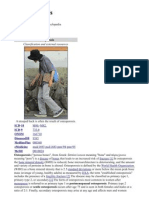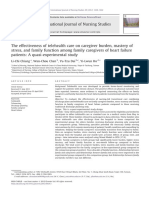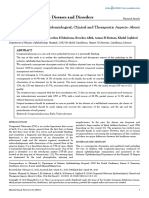Drug Study or
Drug Study or
Uploaded by
Christine Katherine LibuitCopyright:
Available Formats
Drug Study or
Drug Study or
Uploaded by
Christine Katherine LibuitOriginal Title
Copyright
Available Formats
Share this document
Did you find this document useful?
Is this content inappropriate?
Copyright:
Available Formats
Drug Study or
Drug Study or
Uploaded by
Christine Katherine LibuitCopyright:
Available Formats
NAME OF DRUG CLASSIFICATION AND ACTION INDICATIONS CONTRAINDICATIONS NURSING RESPONSIBILITIES
Generic Name: Therapeutic: • Management of • Assess patient for nausea, vomiting, abdominal
METOCLOPRAMIDE Antiemetics heartburn caused by distention, and bowel sounds before and after
In patients with a history of
esophageal reflux administration.
ACTIONS hypersensitivity to
Brand Name: PLASIL Physiologic Mechanism • Treatment and metoclopramide or any of • May cause drowsiness.
prevention of the components. In the
• Decreased nausea and vomiting. postoperative nausea presence of GI hemorrhage, • Advise patient to avoid concurrent use of
and vomiting. mechanical obstruction, or alcohol and other CNS depressant while taking
• Decreased symptoms of gastric this medication.
perforation. In those with
stasis. It is also used to treat
slow gastric emptying in pheochromocytoma and • Advise patient to notify health care professional
Signs of an allergic reaction: hives; people with diabetes epilepsy. immediately if involuntary movement of eyes,
difficulty breathing; swelling (also called diabetic face or limbs occurs.
of your face, lips, tongue, or throat. gastroparesis). Caution:
Pregnancy and lactation. Extract from history if the patient has epilepsy,
GI perforation,pheochromocytoma, or bleeding
More serious reactions: tremors, or in the intestines. Metoclopramide is usually
taken before meals and at bedtime.
restless muscle movements in your
eyes, tongue, jaw, or neck; mask-like Patient Teaching:
appearance of the face; fever, stiff Instruct to take with a full glass of water.
muscles, confusion, sweating, fast or Narcotic pain medicine, sleeping pills, and
uneven heartbeats, rapid breathing; medicine for anxiety can add
depressed mood, thoughts of suicide to sleepiness caused by metoclopramide.
Avoid drinking alcohol. It can increase some
or hurting yourself; hallucinations,
of the side effects of
anxiety, agitation, jittery feeling, metoclopramide.
trouble staying still; swelling, fluid The drug can pass into the breast milk and
retention; jaundice (yellowing of your may harm the baby
skin or eyes); or seizure
(convulsions).
Less serious reactions: feeling
restless, drowsy, tired, or dizzy;
headache, sleep problems
(insomnia); headache, sleep
problems (insomnia); nausea,
diarrhea; breast tenderness or
swelling; changes in your menstrual
periods; or urinating more than
usual.
Pharmacologic Mechanism
• Blocks dopamine receptors in
chemoreceptor trigger zone of the
CNS.
• Stimulates motility of the upper GI
tract and accelerates gastric
emptying.
NAME OF DRUG CLASSIFICATION AND INDICATIONS CONTRAINDICATIONS NURSING RESPONSIBILITIES
ACTION
NMDA receptor Contraindicated in patients Nursing considerations include close
Generic name: antagonist Indications for use as an anaesthetic: with Elevated intracranial monitoring of vital signs during the initial
Ketamine pressure, hypertension, dosage and follow-up observations of the
hydrochloride high, fully anesthetic Pediatric anesthesia (as the aneurysms, thryotoxicosis, effectiveness of the medications.
level doses: sole anesthetic for minor congestive heart failure,
Brand name: Ketanest, opioid μ receptors procedures or as an induction angina, and psychotic Assess pain and vital signs (VS); reassure
Ketaset, and Ketalar, sigma receptors agent followed by muscle disorders. patient that they may
Ketaset, Ketmex, dissociative anesthesia relaxant and endotracheal experience a dream-like feeling, especially
Ketotal, Ketamine-500 recreational drug. intubation) those who cannot adequately
(Astrapin) and Imalgen Asthmatics or patients with communicate due to their medical
analgesia, anesthesia, chronic obstructive airway circumstance.
Recreational name: hallucinations, elevated disease
blood pressure, and As part of a cream, gel, or liquid Vital signs are checked every four hours after
"K", "Ket", "Special K" bronchodilation. for topical application for nerve the initial dosage along with evaluation of the
and "Vitamin K". pain -- the most common effectiveness of the dosage and observation
used for the induction mixture is 10% ketoprofen, 5% for signs of oxygenation of tissue.
and maintenance of Lidocaine, and 10% ketamine.
general anesthesia, Other ingredients found useful Patients have better mobility and quality of
usually in combination by pain specialists and their life when receiving ketamine as an adjuvant
with some sedative drug patients as well as the therapy, which promotes assistance with their
compounding pharmacists who nursing care.
sedation in intensive make the topical mixtures
care, analgesia include amitryptiline, Side effects may occur from administering
(particularly in cyclobenzaprine, clonidine, ketamine and include nausea, vomiting,
emergency medicine), tramadol, and mepivicaine and dizziness, and emotional distress. Standard
and treatment of other longer-acting local orders help alleviate problems with those
bronchospasm. It is also anaesthetics. symptoms.
a popular anesthetic in In emergency medicine in
veterinary medicine entrapped patients suffering
severe trauma[20]
Effects Emergency surgery in field
conditions in war zones
Impairs all senses, To supplement spinal / epidural
anesthesia / analgesia utilizing
especially: low doses
Sight
Balance
Sense of time
Cardiovascular:
Partial
depressant
Gastrointestinal:
Nausea
Musculoskeletal:
Relaxant
Neurological:
Analgesia
Respiratory:
Partial
depressant/stimu
lant
You might also like
- Nursing Care Plan AnemiaDocument2 pagesNursing Care Plan Anemiaderic88% (136)
- Parales, Danish Stephanie C. BSN 3Y1-2: Her Home Medications Include MonthlyDocument8 pagesParales, Danish Stephanie C. BSN 3Y1-2: Her Home Medications Include MonthlyJanaica Juan0% (1)
- Pharma CardsDocument5 pagesPharma CardsazancheNo ratings yet
- Passmedicine Mcqs-Surgical and Musculoskeletal ProblemsDocument346 pagesPassmedicine Mcqs-Surgical and Musculoskeletal ProblemsMohammad Saleh100% (1)
- Dengue DRUG StudyDocument4 pagesDengue DRUG Studyjaninenicole100% (1)
- DRUG STUDY OnlyDocument5 pagesDRUG STUDY OnlyShannon CabfitNo ratings yet
- Drug StudyDocument7 pagesDrug Studyanne009No ratings yet
- Activity 2 Narcotics & NMJDocument7 pagesActivity 2 Narcotics & NMJKristineNo ratings yet
- V. Implementation Management A. MedicationsDocument3 pagesV. Implementation Management A. MedicationsSid Artemis FriasNo ratings yet
- Drug Study MetoclopramideDocument2 pagesDrug Study MetoclopramidePrince Rupee Gonzales100% (2)
- DRUG STUDY LevetiracetamDocument3 pagesDRUG STUDY LevetiracetamMaria Althea NajorraNo ratings yet
- DRUGSTUDY Private RoomDocument5 pagesDRUGSTUDY Private RoomlordwinjohnbernardoNo ratings yet
- Corticosteroid PrednisoneDocument3 pagesCorticosteroid Prednisone1adie1907No ratings yet
- DS DR RodasDocument7 pagesDS DR RodasChristian MarquezNo ratings yet
- Drug StudyDocument13 pagesDrug Studyapi-3757116100% (4)
- Covid19-Drug StudyDocument7 pagesCovid19-Drug StudynicoleNo ratings yet
- Atropine Sulfate Indications: Adverse Effects: CNS: Headache, Ataxia, Contraindication: Assessment & Drug EffectsDocument4 pagesAtropine Sulfate Indications: Adverse Effects: CNS: Headache, Ataxia, Contraindication: Assessment & Drug EffectsMarie Kris Chua AbelleraNo ratings yet
- NCMH Drug StudyDocument5 pagesNCMH Drug StudyHeartlee NapuranNo ratings yet
- ANTIPSYCHOTICSDocument25 pagesANTIPSYCHOTICSCheetahboi Shopee100% (4)
- Marfori - Activity 3 Antineoplastic Agents Drug StudyDocument3 pagesMarfori - Activity 3 Antineoplastic Agents Drug Studyckkyle0% (1)
- Generic Name Dosage / Frequency Action Side Effects Nursing ResponsibilityDocument9 pagesGeneric Name Dosage / Frequency Action Side Effects Nursing Responsibilityorhocelo6908No ratings yet
- Drugstudy JRODDocument4 pagesDrugstudy JRODPeyjeyNo ratings yet
- Drug Study: Sedation, Dizziness/vertigo, Headache, Hypotension Sweating, Nausea, VomitingDocument1 pageDrug Study: Sedation, Dizziness/vertigo, Headache, Hypotension Sweating, Nausea, VomitingRoland YusteNo ratings yet
- Drug Study On Emergency Drugs Final - )Document12 pagesDrug Study On Emergency Drugs Final - )wen_pil100% (3)
- Drug Study: Phinma - University of Iloilo College of Allied Health SciencesDocument3 pagesDrug Study: Phinma - University of Iloilo College of Allied Health Scienceslhie cabanlitNo ratings yet
- Classification Mechanism of Action Indication Contra-Indication Side and Adverse Effects Nursing Responsibilities Generic Name: ClassificationDocument3 pagesClassification Mechanism of Action Indication Contra-Indication Side and Adverse Effects Nursing Responsibilities Generic Name: ClassificationAngela NeriNo ratings yet
- Drug Study PPS 3RDDocument14 pagesDrug Study PPS 3RDLoren SarigumbaNo ratings yet
- Antiemetics DrugsDocument21 pagesAntiemetics DrugsjutttoxicNo ratings yet
- Assessing Nausea and Vomiting - MateriDocument6 pagesAssessing Nausea and Vomiting - MateriAnnisa Nurul SafitriNo ratings yet
- GCP Cs DrugsDocument13 pagesGCP Cs DrugsBel CortezNo ratings yet
- Metoclopramide Drug StudyDocument2 pagesMetoclopramide Drug StudyRem remNo ratings yet
- Drug StudyDocument11 pagesDrug StudyJohn LesterNo ratings yet
- Ketorolac IVDocument3 pagesKetorolac IVEli Thy IgopNo ratings yet
- Generic Name: Ordered: Indications: Contraindications BeforeDocument3 pagesGeneric Name: Ordered: Indications: Contraindications BeforeChenime Añana0% (1)
- Drug Study Edited FinalDocument10 pagesDrug Study Edited FinalPureza Maye SalapangNo ratings yet
- M&N MGMTDocument3 pagesM&N MGMTMark Jefferson LunaNo ratings yet
- Drug Study For Postpartum MothersDocument5 pagesDrug Study For Postpartum MothersnnicakoNo ratings yet
- Final Drug StudyDocument4 pagesFinal Drug StudyBasema HashhashNo ratings yet
- Emergency DrugsDocument10 pagesEmergency DrugsnieacatleyaNo ratings yet
- Therapeutic Class: Anxiolytic Pharmacologic Class: Benzodiazepine Therapeutic Class: Anxiolytic Pharmacologic Class: BenzodiazepineDocument5 pagesTherapeutic Class: Anxiolytic Pharmacologic Class: Benzodiazepine Therapeutic Class: Anxiolytic Pharmacologic Class: BenzodiazepineAriadne MangondatoNo ratings yet
- Identify The Cause To Control The SymptomDocument3 pagesIdentify The Cause To Control The SymptomKimberly Joy GregorioNo ratings yet
- Drug STUDY FOR TOMORROWDocument7 pagesDrug STUDY FOR TOMORROWRhandz Rhaven MaaghopNo ratings yet
- Drug Sudy CamvilleDocument4 pagesDrug Sudy CamvilleJoshua MendozaNo ratings yet
- Drug Study YyyDocument7 pagesDrug Study YyyIanjoyce OlivarNo ratings yet
- Enicillin-Like Antibiotics. Diarrhea, Nausea, Vomiting, HeadacheDocument5 pagesEnicillin-Like Antibiotics. Diarrhea, Nausea, Vomiting, HeadachePauline AñesNo ratings yet
- Drugstudy PatagueDocument4 pagesDrugstudy PatagueEemyaj JaymeeNo ratings yet
- Promethazine HCLDocument2 pagesPromethazine HCLIvanne Hisoler100% (8)
- Dexamethasone Methylergometrine Maleate Bupivacaine HydrochlorideDocument3 pagesDexamethasone Methylergometrine Maleate Bupivacaine HydrochlorideOmyl-Khayr M. SulogNo ratings yet
- Drug Study OmeprazoleDocument1 pageDrug Study Omeprazoleelmer.platiljrNo ratings yet
- Drug Study: Davao Doctor College Nursing ProgramDocument3 pagesDrug Study: Davao Doctor College Nursing Programember parkNo ratings yet
- W9 PharmacologyDocument5 pagesW9 PharmacologyEh paano kung HindiNo ratings yet
- Pharmacologic Class: Therapeutic Class: Atypical: Dibenzothiazepine Derivative AntipsychoticDocument2 pagesPharmacologic Class: Therapeutic Class: Atypical: Dibenzothiazepine Derivative AntipsychoticBianca Nicole Gacad Fernandez100% (1)
- Drug 2Document4 pagesDrug 2Abie Jewel Joy RoqueNo ratings yet
- Viii. Pharmacologic Intervention (Drug Study)Document10 pagesViii. Pharmacologic Intervention (Drug Study)Cyril Jane Caanyagan AcutNo ratings yet
- CH19-25 PharmaDocument20 pagesCH19-25 Pharmakwon nanaNo ratings yet
- Clinicals Drug ListDocument3 pagesClinicals Drug ListNichole MaddoxNo ratings yet
- Age Drug StudyDocument20 pagesAge Drug StudyLadybelle GototosNo ratings yet
- Benzodiazepines Drug StudyDocument4 pagesBenzodiazepines Drug Studyaaron tabernaNo ratings yet
- Top 100 Drugs Pocket Reference Guide (2023 Edition)From EverandTop 100 Drugs Pocket Reference Guide (2023 Edition)No ratings yet
- Critical Care Medications: Anti-Arrhythmics Study Guide: Critical Care EssentialsFrom EverandCritical Care Medications: Anti-Arrhythmics Study Guide: Critical Care EssentialsNo ratings yet
- Medical Encyclopedia XXL: Prof. J.P. Schadé, M.D., Ph.D. D.Sc.hcFrom EverandMedical Encyclopedia XXL: Prof. J.P. Schadé, M.D., Ph.D. D.Sc.hcNo ratings yet
- Jackie MDocument2 pagesJackie MChristine Katherine LibuitNo ratings yet
- Jackie MDocument2 pagesJackie MChristine Katherine LibuitNo ratings yet
- OsteoDocument2 pagesOsteoChristine Katherine LibuitNo ratings yet
- A Wound Is A Break in The Continuity of A Tissue of The BodyDocument6 pagesA Wound Is A Break in The Continuity of A Tissue of The BodyChristine Katherine LibuitNo ratings yet
- Shreyas Dighe 130721Document2 pagesShreyas Dighe 130721Shreyas DigheNo ratings yet
- Chief Complaint: Body WeaknessDocument13 pagesChief Complaint: Body WeaknessJohn MaglinteNo ratings yet
- Buck Institute 2012 Annual ReportDocument56 pagesBuck Institute 2012 Annual ReportmikalraNo ratings yet
- Pressure Injury - Nursing Care PlanDocument4 pagesPressure Injury - Nursing Care PlanMonique Sacherow BacherNo ratings yet
- Chiang Et Al., 2012Document13 pagesChiang Et Al., 2012Karen TjiaNo ratings yet
- Complications in PregnancyDocument36 pagesComplications in PregnancyJADE PATEGANo ratings yet
- Project Profile On Hand SanitizerDocument16 pagesProject Profile On Hand SanitizerArun PariharNo ratings yet
- Bandages: Andrada, Ramo Jose E. Naknorasing, PimthanwaDocument28 pagesBandages: Andrada, Ramo Jose E. Naknorasing, PimthanwaNdor BariboloNo ratings yet
- Lympathic, Immune, Respiratory and Digestive Systems Homework (Key)Document14 pagesLympathic, Immune, Respiratory and Digestive Systems Homework (Key)Tuna BöncüNo ratings yet
- Curriculum Vitae - Irena KlavsDocument6 pagesCurriculum Vitae - Irena KlavsGodwin ArthurNo ratings yet
- Corn Silk Lemon Grass Tea 1Document50 pagesCorn Silk Lemon Grass Tea 1April Joy DelluvaNo ratings yet
- HFMD FINAL - AzaniDocument8 pagesHFMD FINAL - AzaniGrace BlaiseNo ratings yet
- Congenital Glaucoma Epidemiological Clinical and Therapeutic Aspects About 414 EyesDocument5 pagesCongenital Glaucoma Epidemiological Clinical and Therapeutic Aspects About 414 Eyessiti rumaisaNo ratings yet
- Final Rwanda Hospital Accreditation Standards Performance Assessment 3 Edition 2022Document168 pagesFinal Rwanda Hospital Accreditation Standards Performance Assessment 3 Edition 2022john peter BamporikiNo ratings yet
- Upper Gastrointestinal DisordersDocument40 pagesUpper Gastrointestinal DisordersNoemi GarciaNo ratings yet
- VrukshamlaDocument6 pagesVrukshamladanisterNo ratings yet
- Family Case StudyDocument28 pagesFamily Case StudyAlma Vanessa Mejia Zapatero100% (1)
- Health Assessment Lab Chapter 1Document3 pagesHealth Assessment Lab Chapter 1Japsay Francisco GranadaNo ratings yet
- Online Term Plan: Shriram LifeDocument10 pagesOnline Term Plan: Shriram LifeSivaramakrishna DavuluriNo ratings yet
- (UDISE+) : Data Capture FormatDocument24 pages(UDISE+) : Data Capture FormatGaurav SaoNo ratings yet
- Take Away 2 - Airbus Hazard Prevention Handbook (Distribution Copy)Document41 pagesTake Away 2 - Airbus Hazard Prevention Handbook (Distribution Copy)UbernatorNo ratings yet
- Zindagi e Nau August 2020Document112 pagesZindagi e Nau August 2020azhar binyaminNo ratings yet
- Interstitial Lung DiseasesDocument80 pagesInterstitial Lung Diseasespavithranmbbs100% (1)
- DJ Project-2.1Document94 pagesDJ Project-2.1Rishi RejiNo ratings yet
- ASTMH Diploma Course List 8 - 19Document10 pagesASTMH Diploma Course List 8 - 19saurabh pandeyNo ratings yet
- River Cities Reader #979 - November 2020Document20 pagesRiver Cities Reader #979 - November 2020River Cities ReaderNo ratings yet
- Nephropathy in DiabetesDocument4 pagesNephropathy in Diabetesmarko.nikolitschNo ratings yet
- Clinical Practices and Hemodilysis Elderly OutcameDocument31 pagesClinical Practices and Hemodilysis Elderly OutcamewibisonoanantoNo ratings yet
- Selected Abbrev Used in Prescriptions and Medication OrdersDocument5 pagesSelected Abbrev Used in Prescriptions and Medication OrdersMelekNo ratings yet





























































































